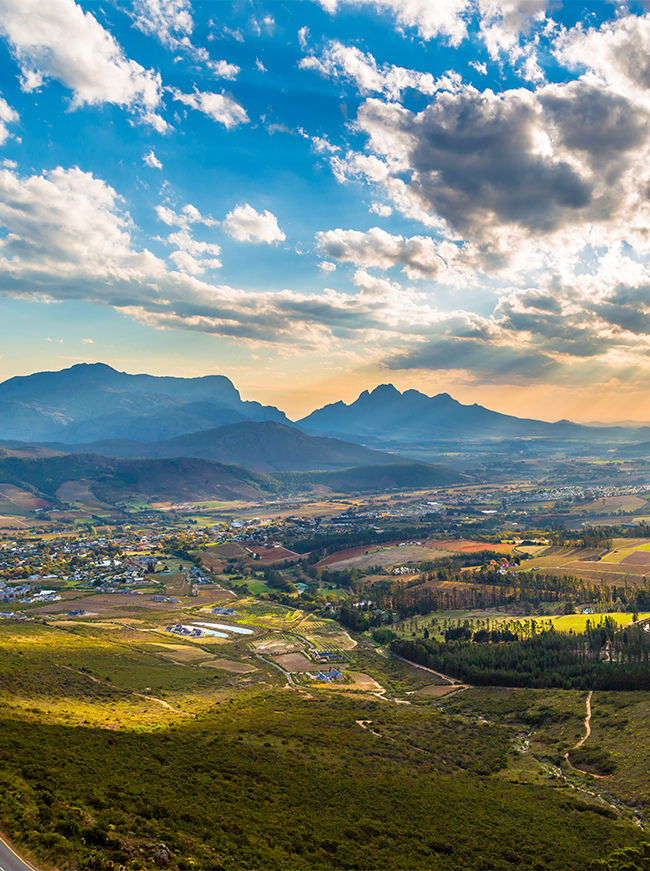Spaceman is his name, access clearly his game. ‘Good morning, sir; how can I help you?’ I wasn’t expecting a gatekeeper, much less one named Spaceman. ‘Good morning, Spaceman. I’m headed to Camp Canoe. Can you point the way?’
Spaceman is Boschendal’s eastern campus guard. Beyond his boom is the working section of the famous wine farm, parts that suggest adventure, intrigue and the unexpected. Like his name.
‘Certainly, sir. I see you’re in the right car too. Okay, you must keep right at Cottage 1685 there ahead, past the Orchard cottages on your right, take a sharp left and keep climbing, right up under Simonsberg. Keep going, even if it feels like you can’t go up anymore. The signs will say “viewpoint”. When it gets really steep you’ll know you have arrived.’
Right then, only slightly intimidated. Indeed, the going is challenging. I’m driving Jeep’s latest Gladiator Rubicon, a cross between a tank and an SUV, so no real problems as the gravel turns to rock and the gradient increases to best-you-engage-4×4. Mountain bikers rocket past me, presumably in control, heading down to Spaceman’s gate, flush with what I hope is aerobic glow and not terror sweats. It’s magnificent up there, the entire Franschhoek Valley below a tapestry of spring expectancy. Plum blossoms, apples, fragrant fynbos, the season’s protea display in all its glory.
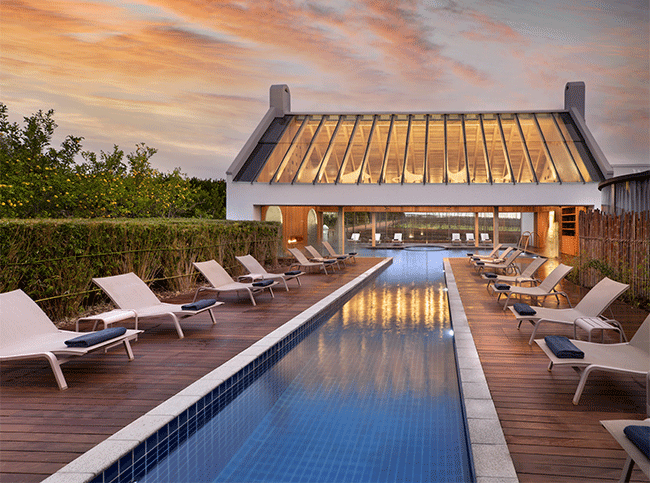
Five minutes later, to the left, is what I’ve come for. A series of exclusive tented platforms, known as Camp Canoe, necklace out from a central dam. Each is mostly hidden from the others. This is Boschendal’s COVID folly, a good idea that fell foul to a pandemic but is now, finally, making a name for itself.
It’s run by Tal Aviram, rented from Boschendal with licence to adapt and change as he sees fit. Each station – bedroom, bathroom, deck and hot tub – accommodates a couple in some opulence, with provision made for two children on luxury fold-up beds, if requested.
The first thing Aviram did was throw out the existing, clichéd animal-print motifs and introduce a playful, modern element. The result is not dissimilar to a chic Scandinavian hotel. He’s also added a much-needed shade layer above the canvas tents, effectively reducing heat build-up, making the standard air conditioning all but superfluous. It’s lovely in those tents, but really it’s all about the deck and the views down that valley. A valley that begs to be explored.
Except it will have to wait. A quick look around, canoe on the dam, bike the trails, hike Simonsberg and explore the larger working farm – a cheery thank you to Spaceman on the way out and then a trek east to the furthest reaches of the Cape Winelands region, over to Paardeberg.
The area between Wellington and Malmesbury is much in vogue at the moment, producing a number of excellent chenin blancs. Their dry-land vines produce small berries that are full of flavour. Prizes and admiration have flowed in equal measure. It’s a beautiful region for those who haven’t visited – green, rocky, an oddly Mediterranean enclave in an otherwise uniformly flat Swartland.
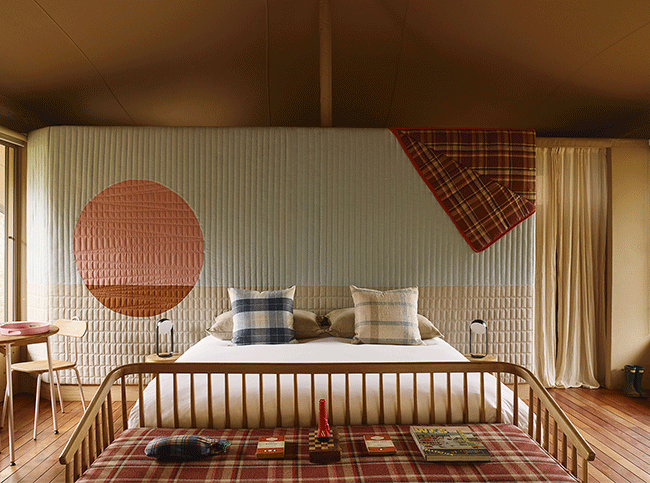
The first stop is Vondeling to experience Matthew Copeland’s Babiana chenin-based blend, followed by a visit to Adama where Praisy Dlamini is doing great things with the Bosman family vineyards. But mostly I’m here to check in with Giuseppe di Benedetto and his winemaker partner Chiara Fabietti. The caretaker couple have created a real buzz over at Ayama Wines. The estate, owned by four Italians, channels Italy even as it celebrates all things local. So it is that the famed Sardinian vermentino grape is grown here, bottled on the farm and sold as a characterful alternative to the regular chenin and grenache. Sat outside on the slope is the old manor house and olives heavy with tradition; it could be southern Italy. Di Benedetto grows artichokes as well, and if you want, head over to the fields and harvest them yourself. The simple farm restaurant attached to the wine-tasting area serves traditional Italian dishes – try the delicious Italian cold platter, artichoke lasagne, parmigiana or the special pie of the day.
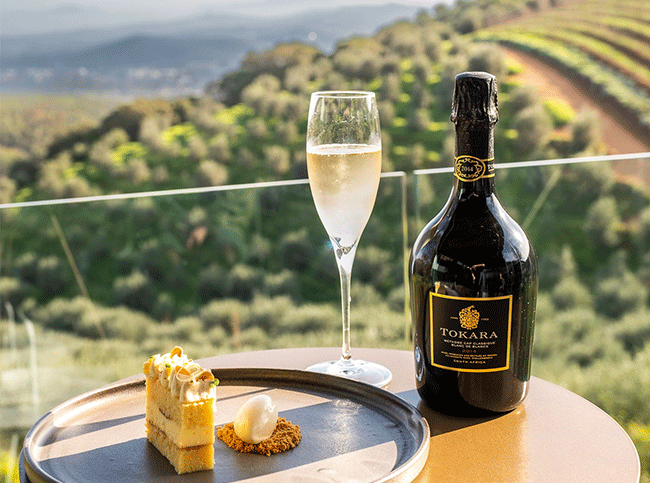
After the gentle emptiness of Paardeberg the crackling fizz of the Franschhoek Valley is a bit of a shock. It’s almost business as usual across the whole region, the anchor tenants of Haute Cabrière under Franschhoek Pass in the east, and Babylonstoren on the Simodium Road in the west bookending a dizzying array of farms and activities in between. A day, a weekend, a week, a month – choose carefully and stay focused, there’s a lot to take in.
For my money, the crucial stop-offs are Delaire Graff for the celebrity-magnet patio, Tokara on Helshoogte Pass for the views, architecture and wildly popular Delicatessen, La Motte for Hanneli Rupert-Koegelenberg’s Pierneef art collection and Leopard’s Leap for chef Christiaan Visser’s family-friendly Rotisserie Restaurant and Harvest Table Bistro.
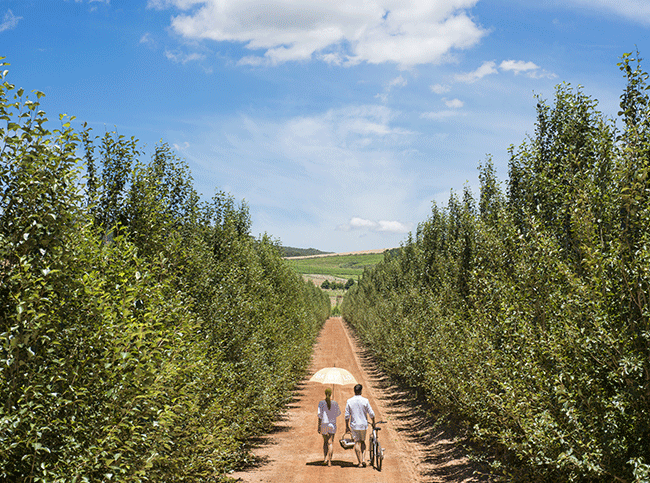
The valley is also very much the epicentre of SA cuisine, and competition for both customers and awards is fierce. Apex chefs working their magic include Peter Duncan at La Petite Colombe on Leeu Estates, Scot Kirton and James Gaag at Epice, David Schneider at Chef’s Warehouse Maison and Adrian Hadlow at Rupert & Rothschild. It’s not uncommon for these food heavyweights to swap staff as well as medals – outside of Constantia and the Cape Town City bowl this is ground zero for food innovation and creativity.
Emerging from the COVID fog, the Winelands have restarted the wider tourism offering. The hop-on, hop-off Wine Tram is running again, taking in the length of the R45 between Vrede en Lust winery and the village of Franschhoek. Eight different lines offer travellers the chance to drink and not drive, eat at leisure and simply hop on afterwards.
There’s more motorised transport over at Johann Rupert’s Franschhoek Motor Museum on the main Franschhoek Road, just after the Elkasun Arabian Stud. The museum is actually a collection of collections, an amalgamation of his father’s Heidelberg Museum collection and various other amassments. What’s on the floor at any given time is only ever a tiny percentage of what Rupert has in the vaults. Just like art collections in major museums, luck and timing determines what visitors see.
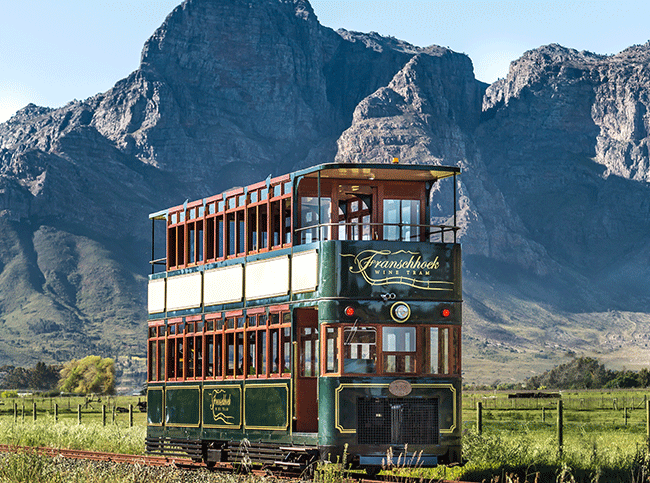
If engines aren’t your chosen form of propulsion, consider hot air. Conrad van Wyk’s sunrise hot-air balloon rides out of Klein Joostenberg on the R304 are also up and running for summer. It’s called Ballooning Cape Town, and Van Wyk brings years of experience with similar enterprises across the globe to bear. It might just be the best way to see the valley, certainly a grand way to contextualise a day’s adventuring. It might even be inspiration enough to attempt the DuToitskop Trail, the area’s most popular hiking route. It starts at the Mont Rochelle Nature Reserve on Franschhoek Pass and climbs 700m up to the summit of the DuToitskop mountain, offering views over the Franschhoek Valley and Wemmershoek mountains.
If the idea of all that exercise is off-putting, motor up the pass instead; the views from the top are astonishing. Carry on down the other side and Cape Town’s largest water source, Theewaterskloof, reveals itself en route to the trendy Overberg towns of Elgin and Grabouw.
The valley’s other consistent drawcard is its spa culture, which has come a long way since the early days of a quick massage tacked onto a hotel stay. The highest-profile spas are at Delaire Graff, Leeu Estates, Babylonstoren and at Le Franschhoek Hotel. Delaire Graff arguably wins the cup – situated on the hillside with endless views across the vineyards, it’s designed along Asian lines, meaning large, clean spaces, water everywhere and restful communal areas, beautifully designed. The spa concept is based on the five senses, with special emphasis on smell, touch and sound.

Equally renowned is Babylonstoren’s Garden Spa, which, as its name suggests, makes full use of the farm’s celebrated setting. Anchored in a bamboo forest far from the hubbub of the larger farm, it includes a Turkish hammam, a salt room and a good old-fashioned plaasdam for swimming. The Leeu Estates spa is run by Healing Earth and Le Franschhoek Hotel spa by Camelot. Both offer stay-and-spa options, either overnight or weekend breaks.
The sun sets on a fresh green forest of new-leaf oaks. I’m back at Boschendal, having stocked up on artisanal bread, organic cold cuts, their legendary pastéis de nata and elderflower cordial at the farm shop. The fruit trees are a riot of pink, and travellers promenade down the avenue of ancients, headed no doubt to Die Werf restaurant for Jason Carroll’s famous Black Angus steak or cured local trout.
It’s moments such as this that the Cape does ‘perfect’ like nowhere else on Earth; fragrant, at peace, archaic but inviting, gentle – a balm for the soul. It’s good to know everyone can enjoy it again.
By Peter Frost
Images: Gallo/Getty Images, Babylonstoren, Camp Canoe, Franschhoek Wine Tram, Tokara
If you ever find yourself in Johannesburg, be sure to check out The 20 Best Restaurants in Midrand.

